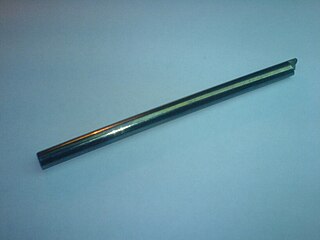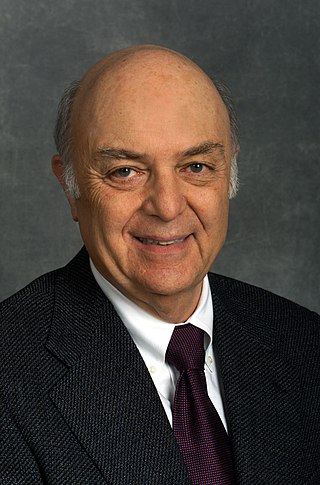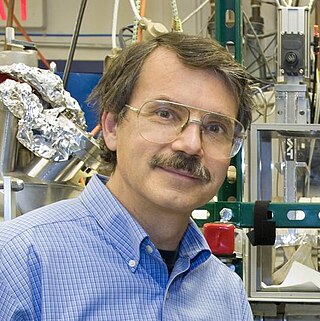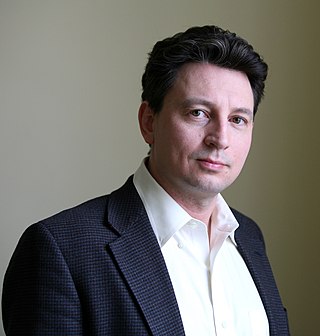Related Research Articles
Phaedon Avouris is a Greek chemical physicist and materials scientist. He is an IBM Fellow and was formerly the group leader for Nanometer Scale Science and Technology at the Thomas J. Watson Research Center in Yorktown Heights, New York.

Bismuth telluride is a gray powder that is a compound of bismuth and tellurium also known as bismuth(III) telluride. It is a semiconductor, which, when alloyed with antimony or selenium, is an efficient thermoelectric material for refrigeration or portable power generation. Bi2Te3 is a topological insulator, and thus exhibits thickness-dependent physical properties.

Marvin Lou Cohen is an American theoretical physicist. He is a University Professor of Physics at the University of California, Berkeley. Cohen is a leading expert in the field of Condensed Matter Physics. He is highly cited and most widely known for his seminal work on the electronic structure of solids.

The Monash University Faculty of Science is one of the largest science faculties in Australia, with over 4,000 students. It offers undergraduate and postgraduate courses, from Bachelor's degrees through to Masters and PhDs. It is based at the Monash Clayton campus in Melbourne, and has extended to Selangor, Malaysia as the School of Science.

Alex K. Zettl is an American experimental physicist, educator, and inventor.
Alexander Rudolf Hamilton is with the School of Physics at the University of New South Wales (UNSW). He is notable in the area of experimental condensed matter physics, particularly semiconductor nanofabrication and the study of quantum effects in nanometer scale electronic devices at ultra-low temperatures.

Walter Alexander "Walt" de Heer is a Dutch physicist and nanoscience researcher known for discoveries in the electronic shell structure of metal clusters, magnetism in transition metal clusters, field emission and ballistic conduction in carbon nanotubes, and graphene-based electronics.

Sir Konstantin Sergeevich Novoselov is a Russian-British physicist, and a professor at the Centre for Advanced 2D Materials, National University of Singapore. He is also the Langworthy Professor in the School of Physics and Astronomy at the University of Manchester. His work on graphene with Andre Geim earned them the Nobel Prize in Physics in 2010.

Alexander A. Balandin is an electrical engineer, solid-state physicist, and materials scientist best known for the experimental discovery of unique thermal properties of graphene and their theoretical explanation; studies of phonons in nanostructures and low-dimensional materials, which led to the development of the field of phonon engineering; investigation of low-frequency electronic noise in materials and devices; and demonstration of the first charge-density-wave quantum devices operating at room temperature.
The Centre for Advanced 2D Materials (CA2DM), at the National University of Singapore (NUS), is the first centre in Asia dedicated to graphene research. The Centre was established under the scientific advice of two Nobel Laureates in physics – Prof Andre Geim and Prof Konstantin Novoselov - who won the 2010 Nobel Prize in Physics for their discovery of graphene. It was created for the conception, characterization, theoretical modeling, and development of transformative technologies based on two-dimensional crystals, such as graphene. In 2019, Prof Konstantin Novoselov moved to Singapore and joined NUS as Distinguished Professor of Materials Science and Engineering.
Stanene is a topological insulator, theoretically predicted by Prof. Shoucheng Zhang's group at Stanford, which may display dissipationless currents at its edges near room temperature. It is composed of tin atoms arranged in a single layer, in a manner similar to graphene. Stanene got its name by combining stannum with the suffix -ene used by graphene. Research is ongoing in Germany and China, as well as at laboratories at Stanford and UCLA.
In materials science, the term single-layer materials or 2D materials refers to crystalline solids consisting of a single layer of atoms. These materials are promising for some applications but remain the focus of research. Single-layer materials derived from single elements generally carry the -ene suffix in their names, e.g. graphene. Single-layer materials that are compounds of two or more elements have -ane or -ide suffixes. 2D materials can generally be categorized as either 2D allotropes of various elements or as compounds.
Alan T. Charlie Johnson is an American physicist, professor of physics and astronomy at the University of Pennsylvania, and the director of the Nano/Bio Interface Center at the University of Pennsylvania.

Xue Qikun is a Chinese physicist. He is a professor of Tsinghua University, Beijing. He has done much work in Condensed Matter Physics, especially on superconductors and topological insulators. In 2013, Xue was the first to achieve the quantum anomalous Hall effect (QAHE), an unusual orderly motion of electrons in a conductor, in his laboratory at Tsinghua University. Xue is a member of the Chinese Academy of Sciences, vice president for research of Tsinghua University, and director of State Key Lab of Quantum Physics. In 2016, he was one of the first recipients of the new Chinese Future Science Award for experimental discovery of high-temperature superconductivity at material interfaces and the QAHE. This award has been described as "China's Nobel Prize".
Elisa Molinari is an Italian physicist from the University of Modena and CNR, Italy. She has been primarily interested in computational materials science and nanotechnologies, and she has been particularly active in the theory of fundamental properties of low-dimensional structures, in the simulation of nanodevices, in the development of related computational methods. She also has a continuing interest in scientific imaging and communication.

The ARC Centre of Excellence in Future Low-Energy Electronics Technologies is a collaboration of physicists, electrical engineers, chemists and material scientists from seven Australian universities developing ultra-low energy electronics aimed at reducing energy use in information technology (IT). The Centre was funded in the 2017 ARC funding round.
Xiaolin Wang is a Chinese-Australian scientist recognised for his work in advanced materials synthesis and characterisation and spintronics. He is director of the Institute for Superconducting and Electronic Materials, University of Wollongong. Wang is a University of Wollongong senior professor, and an Australian Research Council future fellow.

Victor Galitski is an American physicist, a theorist in the areas of condensed matter physics and quantum physics.
Pablo Jarillo-Herrero is a Spanish physicist and current Cecil and Ida Green Professor of Physics at Massachusetts Institute of Technology (MIT).
Tony Frederick Heinz is an American physicist.
References
- ↑ "Three Australian Laureate Fellowships for Monash, Monash University". www.monash.edu.au. Retrieved 22 June 2018.
- 1 2 "Google Scholar - Michael S. Fuhrer" . Retrieved 20 June 2023.
- ↑ "Michael Fuhrer: A new chapter in atomic research". Monash University. Retrieved 22 June 2018.
- ↑ "FLEET Team". ARC Centre of Excellence in Future Low-Energy Electronics Technologies. 31 October 2016. Retrieved 26 April 2020.
- ↑ "Laureate Fellows Announced Big Win for Elite Research Universities". www.theaustralian.com.au. Retrieved 22 June 2018.
- ↑ "New centre for innovative materials research and design launches". Monash University. Retrieved 22 June 2018.
- ↑ Yamamoto, Mahito; Einstein, Theodore L.; Fuhrer, Michael S.; Cullen, William G. (20 November 2013). "Anisotropic Etching of Atomically Thin MoS2". The Journal of Physical Chemistry C. 117 (48): 25643–25649. doi:10.1021/jp410893e . Retrieved 22 June 2018.
- ↑ Yamamoto, Mahito; Einstein, Theodore L.; Fuhrer, Michael S.; Cullen, William G. (20 November 2013). "Anisotropic Etching of Atomically Thin MoS2". The Journal of Physical Chemistry C. 117 (48): 25643–25649. doi:10.1021/jp410893e.
- ↑ "Electronically-smooth '3-D graphene': A bright future for trisodium bismuthide". phys.org. Retrieved 22 June 2018.
- ↑ "Three Australian Laureate Fellowships for Monash". Monash University . 30 July 2012. Retrieved 25 January 2018.
- ↑ "Michael Fuhrer". www.science.org.au. Retrieved 25 May 2023.